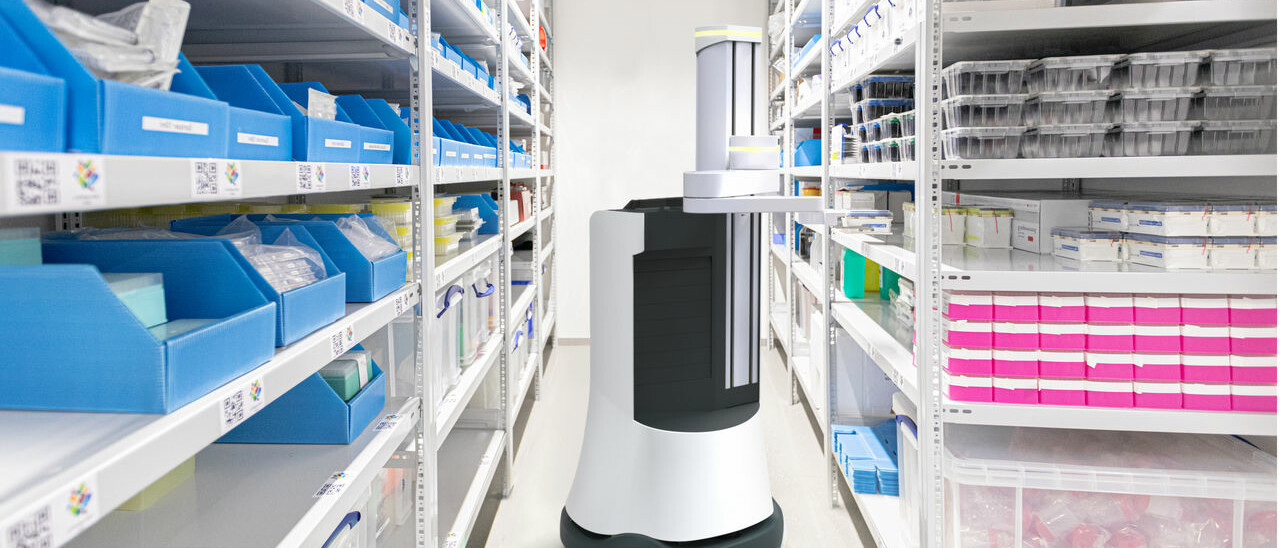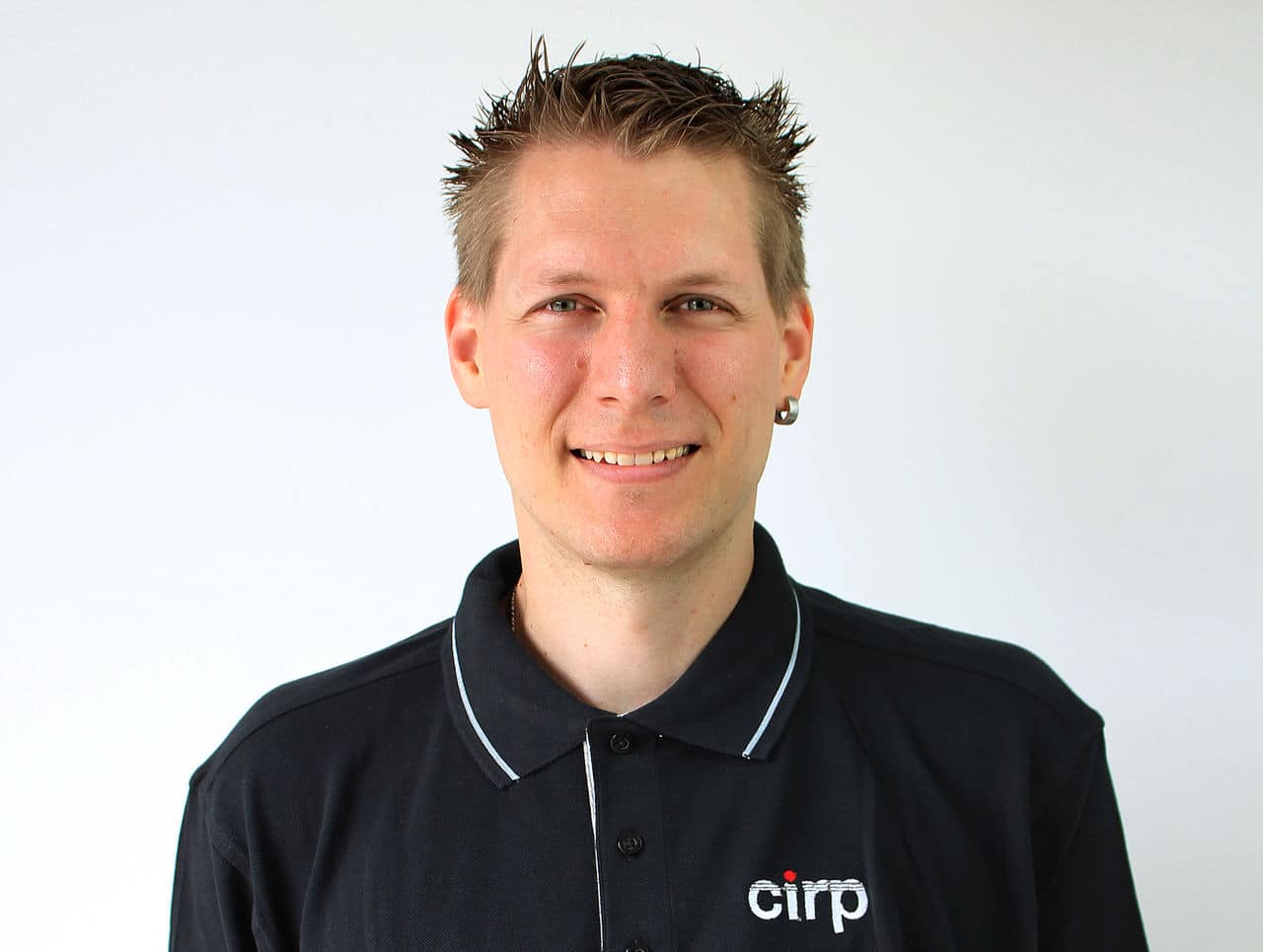Kevin with us at the Motek

Kevin is a laboratory assistant, developed by the Fraunhofer Institute for simple tasks in the laboratory. cirp GmbH brings Kevin to Motek, where he transports a plate with several reagents from device to device. The complete manufacturing and assembly of all cladding components of the first prototype was carried out by cirp: The housing consists of SLA components that were sanded, painted and assembled. This is just one example of the many highlights cirp brings to Stuttgart.
3D printing has already conquered quite a few production areas. Please tell us some aspects that illustrate the advantages of 3D printing:
3D printing or additive manufacturing brings with it the potential to significantly shorten development times through overnight part production, minimize inventory costs through on-demand production, and enable products that were simply technically unfeasible in the past. Additive manufacturing, specifically the laser sintering process, allows product design to incorporate unprecedented design elements, such as bionic structures, undercuts and overhangs, lightweight structures and much more, due to the absolute freedom of construction.
Which industries are benefiting particularly from 3D printing technology?
In particular, the automotive industry benefits not only from the cost and time reduction in development, but also from the newly gained possibility of mass customization. Individually manufactured mass products are revitalizing the automotive market in the interior sector. But other fields, such as (special) mechanical engineering, medical technology, the toy industry, automation and assembly technology, or even areas in the spare parts industry, also benefit from the advantages of additive manufacturing. Key points here would be, for example: one-off productions, precisely fitting custom-made products, individual products, production of components that are no longer available with the help of reverse engineering, etc. This list could be continued at will.
What are the technological obstacles to be overcome in the further development of 3D printing?
Additive manufacturing has been undergoing constant change since its emergence in the 1980s. It all started with stereolithography, from which other technologies such as selective laser sintering, the polyjet process or the well-known FDM process have developed over time. The additive industry is striving to meet the market pressure to be able to manufacture components even faster. Here, the developers come up against physical limits that have to be broken through. The choice of materials has also expanded significantly in the past. I am sure that the customer’s desire to quickly obtain meaningful, injection-molded components will no longer remain a wish in the future.
Which target group do you specifically address with your company?
I would not say that we want to address a precise target group with cirp GmbH. For 27 years now, we have stood for reliability, quality and customer service. This includes both large corporations and private individuals, whom we support with our expertise in the plastics sector and our network. Our goal is to make our customers feel that they are in good hands.
With which trade show highlight will you come to the “Special Show 3D” during Motek/Bondexpo 2021 in Stuttgart?
We will show an additively manufactured spreading head with integrated bellows for spreading contact lens blisters. The translation process is carried out by means of a delta robot. In particular, the SLS material PA2200 enables the production of thin-walled structures that are sufficiently elastic to compensate for the movement of the expansion head. It is custom made.
Also comes with: Robot Kevin. Kevin is a laboratory assistant for simple tasks and for equipping laboratory equipment. Among other things, the laboratory robot transports a plate containing several reagents from instrument to instrument. Kevin was also developed by the Fraunhofer Institute for continuous operation on weekends, holidays and at night. The entire production and assembly of all cladding components of the first prototype was carried out by cirp. The housing consists of SLA components that have been sanded, painted and assembled. The bumpers in the lower area are made of a vacuum cast in soft material.
And another highlight from the project “Mechanical series component for a design luminaire”, the additively manufactured bearing cross: “purmundus” is a registered design brand of cirp and offers an innovative portfolio of 3D-printed table and floor luminaires. The bearing cross is installed as the technical heart in the base of the design lamp and serves as a pressure mechanism for the on or off switch in addition to the attachment to the carbon fiber rod and the circuit board holder.
Also in the trade show luggage: a bistable lampshade kinetic sls. The floor lamp kinetic sls invites interaction. Around its perforated core nestles a second, movably mounted layer of translucent leaves that absorb the special light structure. Simply pulling on two opposing leaf tips opens the shade and paves the way for the light to create a futuristic-looking shadow play. Thus, kinetic sls combines multifaceted light nuances with an innovative technical principle.
And finally, an industrial smartwatch protective case will be on display: Stuttgart-based start-up aucobo offers leading human-centric smartwatch solutions for industrial store floor management. The automated and intelligent distribution of information enables significantly more effective collaboration thanks to the new way in which people and machines are networked, and ensures comprehensive digitization in production and logistics. The summarized information is transmitted directly to the wrist via smartwatch. A protective cover should reliably protect the end device from damage and dirt in the production areas. As a project partner, cirp supports the company in the production of the shell with their complete service package from 3D digitization and conception to the selection of material and technology to the finished product. The first prototype was 3D printed in TPU. The series part is currently being injection molded using a skin-compatible material.
